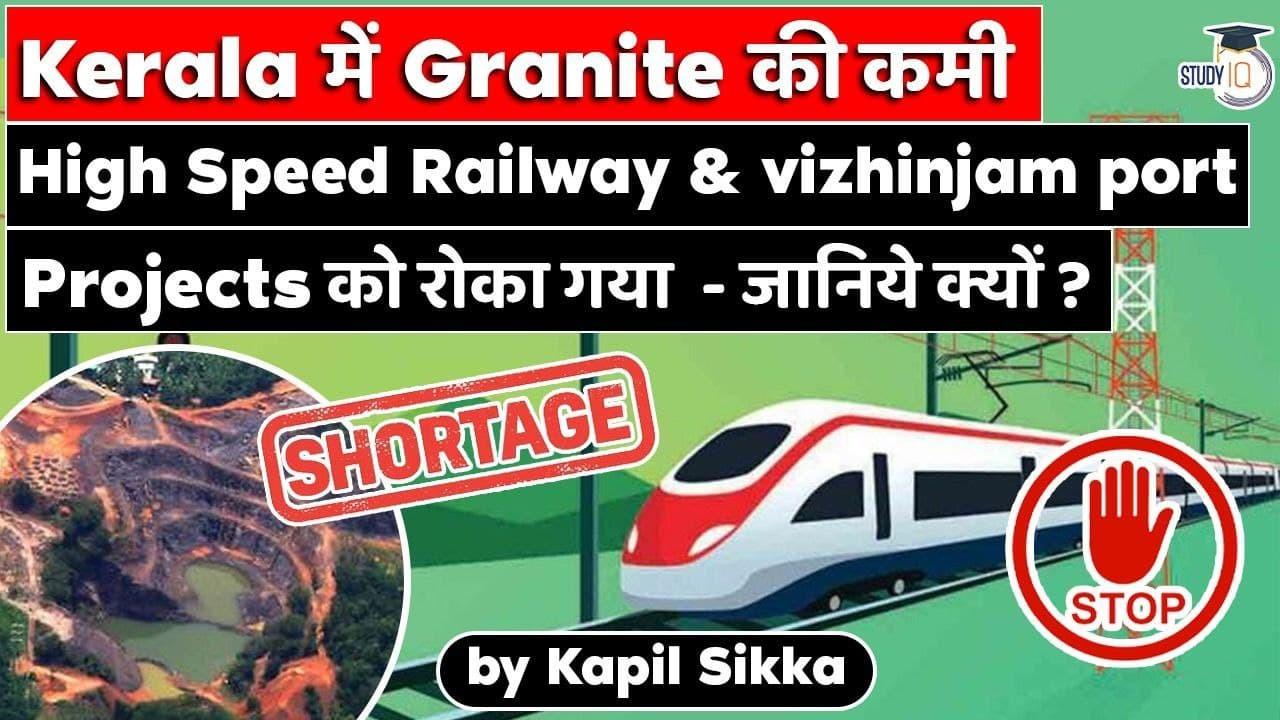Table of Contents
The granite scarcity problem in Kerala
Why are Wayanad district’s construction projects facing delays?
How are environmentalists reacting to the granite shortage?

- While the Kerala government is pressing ahead with ambitious projects like the SilverLine semi-high speed railway line, almost every district in the State is, ironically, facing a dire shortage of construction material, granite in particular, owing to curbs in quarrying on account of ecological concerns and in the wake of public protests.
- The frugal supply of granite has put the brakes on all major constructions including the Vizhinjam Port Project.
- Local non-availability of granite and red earth has also pushed up construction costs across the State, more so in districts like Wayanad where a ban on quarrying in revenue land has been in force for some time now.
- The struggle for a balance between ecological considerations and physical infrastructure development is real and more pronounced in the hill districts of Kerala.
Has the construction sector hit a stone wall in Wayanad?
- All types of construction – from private residences to houses for tribals under various schemes, house construction for the homeless under the LIFE (Livelihood Inclusion and Financial Empowerment) Mission, building of roads and bridges and irrigation canal projects – have been hit by the sparse availability of granite in the district.
- Since it is transported from quarries in the nearby Kozhikode, Kannur and Malappuram districts, the prices have gone up, causing public resentment over the cost escalation.
What happened after quarrying in revenue land was banned?
- Unrestricted granite-mining, quarrying and stone-crushing at three tourism sites in the biodiversity hotspots of Ambalavayal and Krishnagiri villages in the district were banned about six years ago.
- These areas were thought to be at a high risk of landslides, forcing the ban.
- There were about 150 granite quarrying units in these areas prior to the ban.
- “The price of granite has increased manifold ever since they were shut down,”
- Only half a dozen quarries are functional in the district right now.
- And they reportedly charge the same price as the stones ferried from the nearby districts.
- transporting granite to Wayanad in hundreds of mutli-axle trucks daily along the fragile and narrow Ghat road to the district poses its share of environmental, economic and mobility problems.
- solution lies in implementing the proposed Nilambur –Nanjangud railway line.
Is there a way to break this logjam?
- Environmentalists are only opposed to quarrying in ecologically fragile areas.
- Not opposed to quarrying in other areas for the development needs of the people.
- But such mining units should be directly managed by the local bodies, not by private individuals,
- Meanwhile, using alternative construction material should be explored.
Is the situation better in other districts?
- Granite for constructions in Thiruvananthapuram, Kollam and Pathanamthitta districts in south Kerala is sourced from Tamil Nadu.
- “All major works are making a slow progress and small contractors are in a crisis thanks to this,
- while the government closed down about 4,000 small and medium quarries, the much bigger ones with owners linked to political honchos are functioning.
- “But that’s insufficient to meet the huge demand,”
- “The government, however, doesn’t take into consideration any of these aspects while inviting tender for projects which more often than not end in higher costs, inferior quality of work and inexorable delays,”

What is Granite?
- Granite is a common, coarse-grained, hard igneous rock consisting chiefly of quartz, orthoclase or microcline, and mica. Granite has been used as a building material since ancient times.
- It is one of the oldest and most durable building products available, and will far outlast the building in which it is installed
Processing

- Extraction (more commonly referred to as quarrying) consists of removing blocks or pieces of stone from an identified and unearthed geologic deposit.
- Differences in the particular quarrying techniques used often stems from variations in the physical properties of the deposit itself—such as density, fracturing/bedding planes, and depth.
Grinding
- Once the slabs are cut and marked, they are then sent for grinding.
- Grinding is a process to smoothen the surface of the granite, so they lose their grainy finish, as a result of the cutting process and achieve a smooth to touch finish.
Finally polishing and finishing
- Granite is a conglomerate of minerals and rocks, primarily quartz, potassium feldspar, mica, amphiboles, and trace other minerals. Granite typically contains 20-60% quartz, 10-65% feldspar, and 5-15% micas (biotite or muscovite)






















 WhatsApp
WhatsApp